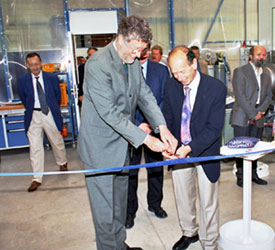URL: https://www.desy.de/news/news/archive_before_2010/2003/ilc_1607/index_eng.html
Breadcrumb Navigation
German-French Collaboration on TESLA Accelerator Technology
Test Stand for Radio-Frequency Couplers Inaugurated in Orsay

From right: Prof. Michel Spiro and Prof. Albrecht Wagner inaugurate the test stand in Orsay.
A new test stand for so-called radio-frequency (RF) couplers is taking up operation at the French Laboratoire de l’Accélérateur Linéaire (LAL, CNRS/IN2P3) in Orsay. On July 7, Professor Michel Spiro, Director of IN2P3 (Institut National de Physique Nucléaire et de Physique des Particules) and Professor Albrecht Wagner, Chairman of the DESY Directorate, officially inaugurated the test stand. The facility was constructed and equipped within the framework of a cooperation agreement between the IN2P3 and DESY. It will be used for the testing and optimization of RF couplers, which are important components of superconducting accelerators.
German and French scientists have thus intensified their cooperation within the international TESLA collaboration. This currently comprises 49 institutes from 12 countries, which are working together under the leadership of DESY to develop the technology for a superconducting linear accelerator. This accelerator technology will provide the basis for two major projects: On the one hand, a free-electron laser for X-ray radiation (XFEL) is to be built in a European collaboration. On the other, developments are under way for an electron-positron linear collider (TESLA), which is being planned as an international joint project.
Developing powerful RF couplers for superconducting accelerators is a completely new technological challenge. These couplers transfer the very high electrical power of 1 to 2 megawatts needed for particle acceleration onto the resonators. In a superconducting accelerator, the couplers have to transmit this power and be very good thermal insulators at the same time. This is because they form the interface between the outer and the inner temperature of the resonators: Whereas the “head” of the coupler has to work at room temperature, the transmitting antenna – the “foot” of the coupler – is subjected to icy -271 degrees Celsius inside the vacuum pipe.
In order to meet these extremely high requirements, the team has to develop a very complex arrangement of metallic and ceramic parts, which has to be assembled under very clean conditions. Later on, the corresponding expertise is to be transferred to industry, since only industrial companies are able to produce the thousands of couplers required for the future accelerators.
The new test stand at the LAL in Orsay will offer ideal conditions for this development work: a completely equipped clean room, a thermal vacuum chamber and a system comprising a modulator and a 5-megawatts klystron.


